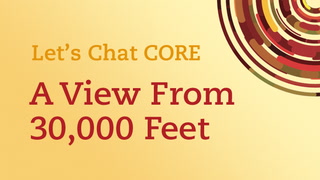Teaching Channel Transcript:
Let’s Chat Core: Learning to Read the Core, A View from 30,000 Feet.
Welcome to Let’s Chat Core! My name is Sarah Brown Wessling. I’m a High School English teacher at Johnston High School in Johnston, Iowa but I also am the Teacher Laureate for Teaching Channel. And here at Teaching Channel, we’re working really hard to give you resources with which to come to terms with the Core. So this is one of the several webinars that we’re going to offer in short manageable pieces to help you feel more confident about the way in which you understand the Core.
Our goal today is really to learn how to read the Standards. By the end of our time together, I would love for you to be able to have a greater sense of confidence when you come to look at the document as well as a greater perspective.
A little history about the Core, it was unveiled in July of 2010. Since that time, two different organizations have really come together to try to make sense of how to elevate the learning of all students in the country. The National Governors’ Association as well as the Council of Chief State School Officers otherwise known as CCSSO came together in order to create the Standards and they did this in some ways because they knew that other countries that were experiencing a great deal of success had a very clear set of Standards in which to follow. So this website www.corestandards.org is a wonderful resource if you want to know more about the history of the Standards.
Along with the Standards themselves is the assessment component. This component leaves a lot of questions for us still because it’s still in progress. The assessments are still being written but there are some things that we do know for sure about the assessments. One of the things that we know is that every State that has adopted the Common Core States Standards belongs to one of two Assessments Consortiums: either the Smarter Balance or the Parcc Assessment Consortium.
Both of these consortiums are working to create assessment that gives us some terminology that you may or may not be familiar with, but as we’re learning about these assessments, you’re probably going to hear words like computer-aided testing or CAT testing, which mean that a lot of the assessments will be delivered on the computer. We’re also hearing terms like next-generation sssessments, which means that these are trying to be different than what we’ve understood about standardized tests in the past. Also implicit in this assessment is an aim to have a formative component, which means that students would practice the assessments as they go along before they give the final summative pieces.
As I think about the Standards, perhaps one of the most important epiphanies for me has been to understand that “common” doesn’t mean the same and that the standards are not curriculum for us. We hear that phrase “Common Core State Standards” and that word common stands out, and a lot of times we think “common” means that everybody is going to be doing the same thing: everybody is going to teach the same thing, going to the same page, on the same day, there are only certain science labs that people will be able to do and that’s not true at all. Because what common means is that we’re working toward a common goal, it means that we’re going to start using common language in order to talk about what our students are learning, but the standards themselves are not curriculum.
The standards are very skill based, and curriculum is what makes our work unique. So the curriculum that is in your district is not going to be the same curriculum as in my district. So while we’re all working toward the same common end in mind, how we get there, those curriculums, the vehicles that we take to travel that road are going to be very different, and very individualized to our students and our students’ needs.
When I think about reading the standards, just figuring out how to read these standards, I kind of think of putting on a set of glasses or a set of lenses. The first sets of lenses that I would use are really the lenses that I would use to observe the standards in front of me. The standards themselves are divided into two big categories right now. We have the Math Standards and we have the Literacy Standards. The Math Standards read actually a little bit differently than the ELA or Literacy Standards.
Right now I just want to show you a screen shot of one of the first pages in the Math Standards so that when you go to look at this document, you can do it with confidence. You can see that the first heading is called the domain, this is the big idea of the standards. Underneath that is the standard itself that is also in bold and then we have these numbered items and those are called clusters and those get more specific for each content area.
Another component of the Math Standards that I think are really beautiful are called the Mathematical Practices because the Math Standards things get pretty specific pretty quickly in terms of exactly what kind of math skills students need to have and how those might be different for Algebra or Geometry or even Calculus. What stays really consistent K-12 are these Mathematical Practices and these are beautiful habits of mind that we want our students to be able to embody in order to act like mathematicians. You can see on this page that when we look at the Kindergarten overview, there’s a phrase “Algebraic thinking for kindergarteners”-- so we realize that the thinking as a mathematician is so important that we want even our kindergarteners to start to do some of those basic moves in order to achieve that.
I’ve had a few Ah-ha moments with the Math Standards and I thought I would share some of those with you. First of all, one of the things that I really found as I work to make sense of them is that there is a clear desire to have more focus, more coherence, and more rigor for our students and perhaps most importantly, we want our students to understand the habits of mind of math.
We don’t just want them to get the right answer but as teachers, we need to be able to teach the thinking skills about numbers so that they can transfer that learning to more difficult and changing problems. I also have found that all roads lead to Algebra when it comes to the Math Standards that really what we’re working toward being able to get our students to do. And again that has a lot to do with how our students think.
One study that really illuminated this for me, is the TIMSS study of 2007 in which researchers discovered that in other countries, there was a lot more focus on grade bands. Say for example, kindergarten and first grade, students spent all kind of time just focusing on just whole numbers and all of the applications of whole numbers.
They had an incredible depth of knowledge about whole number. So when they got to second grade and third grade, they were able to transfer those skills into more difficult work.
In the United States, they found that teachers were teaching whole numbers over and over and over again. So the thinking has been that we need to provide students with the greater depth of knowledge about fewer elements of Math in order to help them transfer that knowledge. Finally, the road to Algebra is traversed through fractions, which means that in order for our students to be Algebraic thinkers, they really have to be able to understand fractions and in order to understand fractions, you have to understand a lot about whole numbers. So, you can kind of see how this is working to be very tightly aligned.
Shifting away from Math Standards and now taking on the other chunk of the Common Core, which is the Literacy Standards. I want to show you again a screen shot of what this standards look like. First of all, right now I’m going to talk very specifically just about Literacy and not just the English Language Arts component because this can cause a lot of confusion for people sometimes. They think that English Language Arts part of the standards mean that it’s just for English teachers but the standards really tell us that everybody in the building is responsible for literacy.
So, everybody in the building gets Reading Standards and Writing Standards. I do need to make sure though, that it’s clear for us to understand that when we’re talking about kindergarten to fifth grade, these are all embedded together so we don’t see the Social Studies Standard pulled out, we don’t see the Science Standards pulled out. Instead we see them all together K-5. When they do get pulled out, we’re starting at sixth grade to twelfth grade level regardless of what you’re looking at, whether it’s the Reading Standards or the Writing Standards.
One of the benefits of the way these are written is that we get the same anchor standards all the way from K-12 so whenever you look at any grade level standards,
You’re going to see that they’re organized by this big heading. They’re going to be organized by key idea and detail, craft and structure, integration of knowledge and ideas. So this is what the reading anchor standards look like. Next we have the writing anchor standards and you can see that again. It’s organized in a very similar fashion. We’re just talking about these two large components of literacy.
Moving away from looking at the anchor standards themselves, I want to offer some of these big shifts in terms of broad strokes that we would see in literacy and English Language Arts, all of these shifts, all the changes that we would see occurring in kindergarten through 12th grade in various ways. So the first thing that we would notice is that the standards are telling us that we have to teach more non-fiction, that students have to be able to do more than know the beginning, the middle, and the end of the story-- that they need to understand the components of non-fiction.
Secondly, the standards are letting us know that there really is a difference between these ideas of argument and persuasion, may be we’ve been defaulting to persuasion a little too much in our instruction that maybe we’re relying too much on the emotional arguments and we often find in persuasive pieces, instead of may be the logical rational argument that we often times find in argumentative pieces.
The Core is going to require us to integrate. It would be incredibly difficult to manage all of the standards themselves if we just saw them as isolated events in the student’s life. We don’t really want to put all of these standards into little checkboxes for students to mark off or for teachers to mark off instead we want to be sure that we’re integrate them whenever we can.
Students are going to be asked to ground their thinking in textual evidence everywhere in these standards. This is really crucial because so often students can talk about how they feel about something or they reaction to something and while that’s a good entry point, we want their exit point as students to be grounded in what they read.
Our texts can no longer be in isolation, this means the day of the parade of texts is over, you know from my experience that was: we’re introduced to a book, we read it, we take a quiz, a test over the book and then it kind of exits the class, as though it’s just a parade that gone by. Instead the books and the texts that we bring into our classrooms have to be able to talk to each other.
And finally, there is this role of textual complicity in the core which mean that we have be very thoughtful about the texts that we put in front of our students to make sure that they’re meeting their needs. Well, I could go on and talk in greater depth about all of these right now. I’m going to save that for some other webinars that you’ll be able to tune in and get more background and more practical application of each of these components.
As we look back at the webinar today, a few ideas standout, first of all, we want to remember that standard is not a common purpose-- that we want the students to think like mathematicians and that for Literacy and ELA teachers, primary texts have become really important and evidence that they use to talk about them, is equally as crucial.
As a teacher too, I also am on my own journey and understanding the Core and because of that I know this is an on going process so we have more discussions that we would like to offer and more resources that we would like to share in other webinars that will continue to be available on TeachingChannel.org
Thank you so much and we’ll see you soon.














58 Comments
DANIEL CHARISIOU Nov 2, 2014 8:13am
Joseph German Oct 1, 2014 11:11pm
Joseph German Oct 1, 2014 11:08pm
Joseph German Oct 1, 2014 11:04pm
Joseph German Oct 1, 2014 10:58pm